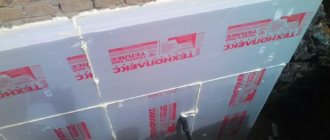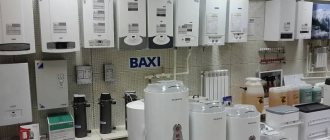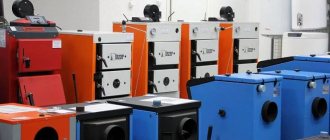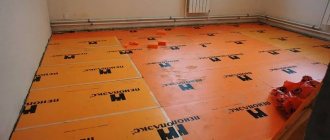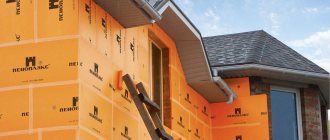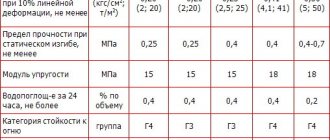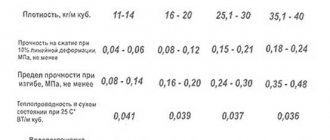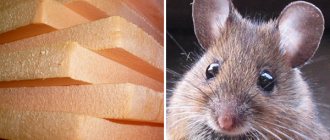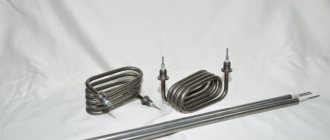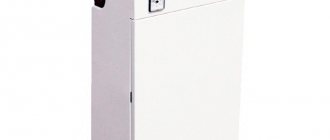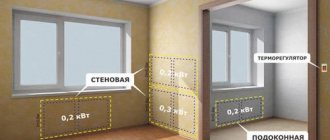"Technoplex" and "Penoplex" are insulation materials that have high technical properties. They appeared on the market not so long ago, but have won the recognition of many. Let's figure out what the advantages and disadvantages of these materials are, what their features and differences are. Let's find out which insulation is better to choose and what to pay attention to, and compare several options.
Wall insulation Source optimole.com
Technical and physical characteristics of the material
The manufacturer indicates the performance and other properties of the insulation on the packaging. Having carefully studied the instructions, you can understand that the technical characteristics of Technoplex (50 mm) look like this:
- sheet thickness – 50 mm;
- average density of the material – 26-30 kg/m³;
- compression resistance – up to 25 tons/m²;
- material water absorption rate (per day) – 0.2% of the total volume;
- use in the temperature range – from -70 to +75°C;
- flammability class - G4;
- heat capacity indicator – 1.45 kJ;
- vapor permeability coefficient – 0.01 m/h/Pa;
- bending strength – not less than 0.3 MPa.
As you can see, with low weight and minimal thickness, the material has the ability to withstand heavy loads, which significantly expands the scope of its application.
It is also important that this type of insulation is not prone to rotting or infestation by rodents and fungi. During operation, it does not emit harmful substances into the air and remains resistant to most chemical compounds (except gasoline and organic solvents)
Advantages and disadvantages
Any building material has its own strengths and weaknesses, which determine the area of application. Technoplex was no exception. The undeniable advantages of insulation include the following:
- Resistance to wet environments
- Reduced frost resistance coefficient, which eliminates the need to lay a layer of waterproofing
- Resistance to mechanical damage and dynamic loads
- Neutrality to most active substances
- Ease of installation
- Long service life without loss of original qualities
Among the disadvantages are the following:
- Material is burning
- When interacting with complex carbons, a conflict of materials occurs, which leads to destruction of the insulation structure. An unsuccessful example of a combination of components: insulation with Technoplex when facing with siding
- Sensitivity to prolonged exposure to direct sunlight
- Limited range of operating temperatures, which does not allow the material to be used for insulation of baths and saunas
The disadvantages include the high cost, which, however, is justified by the high technical characteristics and almost eternal service life.
Dimensions of extrusion insulation
In order to correctly determine the required number of slabs, you should study in more detail the characteristics of Technoplex 50 mm. How many slabs are in the package, and what size they are, you can, of course, check with the seller, but it is better to have this information in advance.
So, from information from the manufacturer we know that the described slabs come in two types:
- with dimensions 118 x 58 cm;
- size 120 x 60 cm.
Also, insulation sheets can have different widths (from 20 to 100 mm). But since slabs with a width of 50 mm are considered the most universal, our article is devoted to them. One package contains 6 slabs of the same size.
Video description
A comparison of both insulation materials is clearly shown in the video.
Since both insulation materials have the same source material, they are harmless to the environment and humans, and are not afraid of almost any building mixtures or solutions. Throughout the entire service life, subject to operating conditions, no harmful substances are released. The flammability of both insulation materials is the same: they easily ignite and release asphyxiating substances. It is recommended to pre-treat the sheets with fire-retardant compounds.
Installation of both materials is similar and does not require special knowledge; a novice master can easily handle it.
Despite the strong similarity, most often the choice is made in favor of Penoplex. There are several reasons for this:
- Price . Penoplex is about 10-15% cheaper than Technoplex. For large volumes of work, the difference in cost can be significant.
- Sheet size . Both insulation materials have similar widths (58 and 60 cm) and thickness (from 2 to 15 cm), only the length differs. "Penoplex" is sold in slabs 120 cm long, less often 240 cm (only at maximum density). "Technoplex" is produced in the form of sheets of various lengths: 120, 240, 300, 400, 450 cm.
Insulation from outside Source avrora-sm.ru
Application and types of penoplex
Considering that penoplex has a number of advantages, its scope of application is quite extensive. EPS serves as an excellent insulation material both indoors and outdoors. It is perfect for apartments, houses, cottages and other buildings. Penoplex can be used to insulate roofs, attics, and balconies, in any climatic region without the use of an additional moisture-proof layer. Since the material practically does not absorb water, it is quite possible to use it in an environment with high humidity. At the same time, its thermal conductivity remains almost unchanged. EPS sheets of various thicknesses are available for sale, and depending on the specific requirements, you can always choose the best option.
In addition to a variety of sizes, extruded polystyrene foam is available in several types depending on density and application. Let's look at each type:
Penoplex Wall. The old name is Penoplex 31 with fire retardants. This material has a density of 25-32 kg/m³ and is intended for effective insulation of external and internal walls, partitions, and plinths. These slabs are also used in the construction of buildings when constructing walls using “well masonry”. Compared to traditional brick walls, such walls are much thinner, but are not inferior to them either in reliability or in the ability to retain heat. In case of insulation of external walls with penoplex, a plaster system can be made on top of the insulation using a mesh, or it can be lined with any façade cladding material (siding, tiles, lining).
Penoplex Foundation. The old name is Penoplex 35 without fire retardant. This material has a density of 29-33 kg/m³ and has high thermal insulation characteristics, a minimum coefficient of water absorption and resistance to chemical and biological destructive factors. Its water-repellent ability allows it to be used as a waterproofing coating. Penoplex Foundation is a rigid slab with a stepped edge, used in the construction of basements, foundations, and insulation of septic tanks. The slabs are very durable and can withstand significant loads. Therefore, they can also be used as a basis for garden paths, plinths, and floors.
Penoplex Roofing. The old name is Penoplex 35. This material has a density of 28-33 kg/m³ and well insulates the building from cold air, has minimal water absorption, the ability to insulate noise well, and has a long service life. The slabs have a standard size of 600x1200 mm, but if necessary they can be easily cut with any available tool. And the light weight of the slabs allows them to be used without reinforcing roof structures. The stepped edge located along the perimeter acts as an additional guarantee that “cold bridges” will not form at the joints of the slabs. This type of penoplex can be used to insulate any type of roof. However, more often this insulation is used for insulating flat roofs, as well as for insulating the attic space of a ventilated roof.
Penoplex Comfort. The old name is Penoplex 31C. This material has a density of 25-35 kg/m³ and has an extremely low thermal conductivity coefficient, high hydrophobicity, and excellent ability to insulate noise. It does not rot and is not a favorable environment for the settlement of insects, mold and fungi. Penoplex Comfort is produced in the form of slabs measuring 600x1200 mm, which have a step-shaped edge along the perimeter. It serves as an additional guarantee of accurate installation. Being a kind of universal, this insulation is simply ideal for thermal insulation of a private house. They can be used to insulate floors, foundations, basements, roofs and walls.
Penoplex 45. This material has a density of 35-47 kg/m³ and is used as insulation for road surfaces, in particular runways, to prevent them from frost heaving of the soil and destruction of the top layer of the road surface. It is also widely used for insulating roofs in use, on which there are pedestrian areas and various areas, including parking lots.
Internal wall insulation with technoplex
Similar work is carried out during the reconstruction of a home. It is also possible to insulate walls from the inside when the façade finishing has been completed recently. Preference should be given to technoplex sheets with a maximum thickness of 40 mm .
Since internal fastening is used in this case, the plates do not need to be fixed with dowels. Experts recommend leaving a small gap between the wall and the insulation itself. This will help reduce heat loss, but will lead to a reduction in living space. It is better to leave a distance, because this will provide natural ventilation. Accordingly, condensation will not penetrate inside, which means the humidity level in the room will remain optimal. This will help avoid rotting, and the walls of the house will dry out very quickly after rain.
When the insulation work using technoplex is completed, the wall surface must be finished . Wooden sheathing is often used for these purposes. It is also possible to use sheets of plasterboard, which are subsequently coated with paint or wallpaper.
Among the variety of modern insulation materials, special attention should be paid to technoplex. This material has excellent thermal insulation properties, thanks to which you can insulate your home both inside and outside. In this case, the help of professionals is not needed.
Description and features of the material
Technoplex insulation is made from polystyrene granules, which, under the influence of high temperature and high pressure, are mixed with a special foaming composition and graphite. The viscous mass is sent into molds of a certain size, where it hardens and is cut into sheets of standard parameters.
The final product is smooth and dense. The structure of the sheet consists of a large number of small closed cells that do not allow air to pass through. Thanks to this, the characteristics of Technoplex (50 mm) are quite high. Graphite additives significantly improve the thermal insulation abilities and increase the strength of the slabs.
Products are sold in rectangular packaging, the size and weight of which depends on the size of the material.
Performance properties
Technoplex ensures the safety of the home and the people living in it, thanks to its environmental friendliness. Extruded polystyrene foam is made from environmentally friendly materials and is non-toxic. In addition, when using the material, you need to take into account that it belongs to the group:
- flammability G4;
- flammability B3;
- smoke generating ability D3;
- toxicity of combustion products T2
The durability of Technoplext extruded polystyrene foam is ensured by:
- resistance to most aggressive environments, with the exception of petroleum solvents. In addition, the material does not deteriorate under the influence of solar ultraviolet radiation and atmospheric moisture;
- biological stability;
- maintaining properties during repeated defrosting and defrosting. It was experimentally established that even after 1000 times freezing and thawing, polystyrene foam did not lose its properties.
Positive features of the material
The technical characteristics of Technoplex (50 mm thick) indicate that this material allows you to significantly save your budget, since it has improved heat-insulating qualities. Compared to conventional polystyrene foam, the capabilities of this product are two times higher, and if you look at the thermal insulation performance of fiberglass slabs, it becomes clear that their capabilities are 1.5 times less.
In addition, a number of positive properties of the material should be noted:
- Increased strength. The extrusion material is more than 5 times stronger than polystyrene foam.
- High density. "Technoplex" is able to withstand heavy loads, which makes it possible to use it when arranging floors.
- Resistant to moisture. The dense and solid structure of the material does not allow moisture to pass through, while polystyrene foam is capable of absorbing liquid, albeit in small quantities.
Despite the fact that the Technoplex material (50 mm) has quite high characteristics, it still has one drawback - poor vapor permeability. This fact must be taken into account when purchasing extrusion plates for certain jobs.
Cost of products
Penoplex wins this confrontation. It is about 10% cheaper than its brother. At large volumes, this minor difference becomes quite significant. Therefore, in order to save money, it is better to choose the first option. The price in each region of Russia may be different, this should be taken into account.
With all this, we can conclude: each of the insulation materials is an excellent option. They are similar in their characteristics, but, nevertheless, Penoplex is a little better. It turns out that for a lower price you get high-quality insulation material. It is versatile and can be used for different purposes. Technoplex or Penoplex, which is better? Reviews say that each of the materials is good.
Installation features
The process of installing the material itself is simple and will require the performer to have minimal construction knowledge and tool skills. To carry out installation we will need the following tools and consumables:
- perforator;
- hammer and spatula;
- sharp knife;
- tape measure and level;
- marker;
- directly technoplex of the required brand and thickness;
- special plastic dowels with a wide head;
- adhesive mixture for polystyrene foam;
- metal support profile.
When the materials and tools are ready, you can begin installation. First you need to prepare the surface. Most often, technoplex is used for external insulation of a facade or foundation, so the surface must be fairly flat (there is no need to inject it to the nearest millimeter) and clean. Some professionals recommend additionally priming the wall or foundation for better adhesion of the adhesive. This step will not be superfluous, although it is not mandatory.
After preparing the surface, you can begin installing the technoplex. To begin with, the lower horizontal rail made of a metal profile is leveled and secured. When choosing a batten, it is necessary that its width matches the thickness of the insulation board. Then we attach the top rail.
We begin to lay polystyrene foam boards between the guides. To do this, lubricate the surface with glue and press it against the wall (foundation). We check the correct installation using the level. Considering that the solution hardens for a certain time, it is possible to slowly adjust the location of each slab relative to the level to achieve the desired result.
After the glue has completely dried (usually after 2-3 days depending on the brand of the mixture), we proceed to additional fixation of the slabs. To do this, use a hammer drill to drill holes in the surface through the insulation and insert plastic dowels. Due to their design, they have a hollow body and teeth on the outside of the nail. We hammer a steel rod into a special hole, which deforms the dowel from the inside and forces it to be firmly held in brick or concrete.
As a rule, 5 dowels are driven into one slab - 4 at the edges so that the head fixes the adjacent slabs and 1 in the center. Sometimes, in order to save money, they are content with less.
The installation is complete, now you can begin finishing the exterior surface.
Insulation of external walls
Builders, as a rule, perform insulation from the outside. In this case, the area of the room will remain the same. To perform the work, sheets of technoplex 100 mm thick .
If you take a thinner material, you need to use 2 layers of insulation, due to which heat loss will be reduced by 40–60%. Naturally, it is customary to begin external thermal insulation work using technoplex after surface preparation. To do this, the walls are cleaned and then leveled with plaster. Next, the insulation sheets are glued. To ensure they hold well, dowels can be used. In this case, the fastening is carried out end-to-end. Since the coating of techoplex sheets is smooth, the surface must first be roughened.
The slabs are glued starting from the bottom . Thanks to this, they will not mix while the glue dries. Then a layer of special mastic is applied to the surface and a reinforcing mesh is fixed on it, which will make the protective layer quite rigid. Next, treatment is carried out with a primer and finishing compound. As a result, the facade of the house will have an attractive appearance.
Experts recommend performing thermal insulation work in dry weather. It is also worth paying attention to the air temperature. It must be at least 5˚ C.
Description and features of the material
Technoplex insulation is made from polystyrene granules, which, under the influence of high temperature and high pressure, are mixed with a special foaming composition and graphite. The viscous mass is sent into molds of a certain size, where it hardens and is cut into sheets of standard parameters.
The final product is smooth and dense. The structure of the sheet consists of a large number of small closed cells that do not allow air to pass through. Thanks to this, the characteristics of Technoplex (50 mm) are quite high. Graphite additives significantly improve the thermal insulation abilities and increase the strength of the slabs.
Products are sold in rectangular packaging, the size and weight of which depends on the size of the material.
Packaging and storage
The boards are packaged in UV-stabilized film. For ease of unloading, the slabs are laid on foam blocks.
Storage: it is not possible to store XPS TECHNOPLEX slabs under a canopy that protects them from precipitation and sunlight. When stored under a canopy, the slabs should be placed on pallets, stands or bars. It is allowed to store XPS TECHNOPLEX boards outdoors in special packaging that protects them from external atmospheric influences.
Precautionary measures: keep away from fire. Chemically unstable to gasoline, organic solvents, as well as bitumen adhesive with a high content of organic solvent.
The material is produced in sheets measuring 600x1200 mm and thicknesses of 20,30, 40 and 50 mm, and its edge can be smooth or L-shaped (to prevent the appearance of cold bridges and the formation of dampness on the walls).
Technical and physical characteristics of the material
The manufacturer indicates the performance and other properties of the insulation on the packaging. Having carefully studied the instructions, you can understand that the technical characteristics of Technoplex (50 mm) look like this:
- sheet thickness – 50 mm;
- average density of the material – 26-30 kg/m³;
- compression resistance – up to 25 tons/m²;
- material water absorption rate (per day) – 0.2% of the total volume;
- use in the temperature range – from -70 to +75°C;
- flammability class - G4;
- heat capacity indicator – 1.45 kJ;
- vapor permeability coefficient – 0.01 m/h/Pa;
- bending strength – not less than 0.3 MPa.
As you can see, with low weight and minimal thickness, the material has the ability to withstand heavy loads, which significantly expands the scope of its application.
It is also important that this type of insulation is not prone to rotting or infestation by rodents and fungi. During operation, it does not emit harmful substances into the air and remains resistant to most chemical compounds (except gasoline and organic solvents)
The difference between foamed polystyrenes
As mentioned above, the use of liquid and powder gas-forming agents is better, so products obtained using this technology have stable thermal insulation characteristics. Although, this cannot be called the only reason why Technoplex and Penoplex do not contain freon. There are two more:
- Sealed cells of new material that have not yet been used have remnants of freon. Formally, it is called safe, but in reality it is better not to deal with it. It can cause lung problems in children.
- Over time, the gas will be forced out of the cells by air and humidity. And if dirty raw materials containing styrene were used in the manufacture of the material, then the contents will penetrate into the external environment.
And if technical grades of EPS, such as Penofol, are used to treat foundations, highways, and plinths, then the presence of freon in the composition does not affect the material in any way. But to insulate your home, it is better to use safe products. Therefore, the answer to the question: Penoplex or Penofol, which is better, can be answered - the first option.
How do you know which is better Penoplex or expanded polystyrene? After all, many recommend insulating with foam plastic, because it has a low price and excellent characteristics. To answer this question, you need to know how penoplex differs from expanded polystyrene. Let's start with production technology.
Technoplex, Penoplex and even Penofol are created during the extrusion process. This allows you to obtain a very dense linear structure, which affects the material’s resistance to water and humidity, as well as strength. Therefore, foam plastic is somewhat worse than materials created by extrusion methods.
Technoplex insulation technical characteristics
Technoplex extrusion has a low thermal conductivity coefficient, is resistant to mechanical loads, does not shrink, is chemically resistant, and is not subject to decomposition and rotting. Technoplex has technical characteristics in comparison with brick such that the thermal conductivity of 30 mm extruded polystyrene foam is comparable to a 400 mm brick wall. Finnish foundations are often insulated with this material.
Technoplex 50 mm characteristics
Technoplex.
Characteristics of slabs with a thickness of 20 to 120 mm The scope of application of extruded polystyrene foam, due to its high strength and resistance to moisture, is very wide. XPS is used today when pouring USP, insulating strip foundations and blind areas of houses. The material does not lose its original characteristics even in water, since the structure of the material consists of closed cells that do not absorb moisture, unlike mineral wool.
Comparison with other insulation materials
Other materials are also used as insulation. They all have certain features and disadvantages that are worth remembering.
Below we compare Penoplex and:
- Expanded polystyrene . It is produced using a non-press method, due to which the strength and density are reduced. Almost all technical characteristics of polystyrene foam are lower in comparison with Penoplex. The exception is vapor permeability: it is much higher, and therefore it is better to use insulation in rooms with high humidity.
- Styrofoam . Its characteristics are similar to expanded polystyrene.
Foam insulation Source tildacdn.com
- Styrex . Stirex and Penoplex have almost identical characteristics.
- Mineral wool . Made from mineral raw materials by heat treatment. It has different densities (up to 300 kg/cubic meter) and high vapor permeability, can absorb up to 1% moisture. At the same time, mineral wool can withstand temperatures up to +450 degrees. It is best used in rooms with high humidity and in fire hazardous places (workshops, garages, industrial facilities).
- Extrol . It has the same characteristics as Penoplex, but is produced not only in the form of slabs, but also in the form of cylinders or semicircular segments. It is convenient to use for thermal insulation of pipes.
When choosing a material, it is important to pay attention not only to the properties of the insulation, but also to the form of release and the ease of working with them.
Dimensions of extrusion insulation
In order to correctly determine the required number of slabs, you should study in more detail the characteristics of Technoplex 50 mm. How many slabs are in the package, and what size they are, you can, of course, check with the seller, but it is better to have this information in advance.
So, from information from the manufacturer we know that the described slabs come in two types:
- with dimensions 118 x 58 cm;
- size 120 x 60 cm.
Also, insulation sheets can have different widths (from 20 to 100 mm). But since slabs with a width of 50 mm are considered the most universal, our article is devoted to them. One package contains 6 slabs of the same size.
Which is better: technoplex or penoplex
When building any house in Russia, owners ask themselves about its insulation. Today, the insulation market has a large number of items; tiled thermal insulation materials are in particular demand. Among them, technoplex and penoplex have proven themselves. To better understand their properties, you need to make a small comparison of the main characteristics.
Composition of materials and method of their production
Extruded polystyrene foam or penoplex refers to tile heat insulators. It is produced by extrusion from polystyrene.
This method allows you to achieve a uniform structure of the material, consisting of tiny cells with air.
During production, polystyrene granules are mixed at high temperature and pressure, and a foaming agent (light freons with carbon dioxide) is introduced into the mixture. The next stage of production is extrusion. The resulting material has good thermal insulation properties.
Technoplex is also a tile material for thermal insulation. During its production, graphite nanoparticles are added to extruded polystyrene foam; they further reduce the thermal conductivity of the material, while increasing its strength.
Both materials are environmentally friendly, do not support combustion, and do not dissolve in water and soil. They are suitable for private construction, thermal insulation of balconies and the installation of “warm floors”.
Strength of materials
In terms of mechanical compressive strength at 10% deformation, penoplex (type 35) and technoplex XPS30-200 Standard have the same values of 250 kPa. This value depends on the density of the slabs.
The tensile strength during static bending of penoplex is, depending on the type, 0.4-0.7 MPa. The same indicator for technopex is 0.3 MPa. It can be concluded that penoplex is more resistant to static bending, as it can withstand greater loads.
Operating temperatures of materials
Operating temperatures of penoplex are from -50 to +75ºС. The operating temperature range for the technoplex is between -70ºС and +75ºС. Obviously, the temperature range of the technoplex is greater, this is its advantage, but -70ºС is rare even in our country.
Thermal conductivity and water absorption of penoplex and technoplex
The thermal conductivity of penoplex, depending on the type and operating conditions (A or B), is no more than 0.028-0.031 W/mK. This indicator for the technoplex under various operating conditions is 0.031 W/mK. Thus, both materials are effective thermal insulators.
The water absorption of technoplex is no more than 0.2% by volume in 24 hours. The water absorption of penoplex (type 35) is only 0.1%. Penoplex immersed in water for 28 days increases by only 0.2% of its volume. This indicates the negligible water absorption of penoplex.
In addition, this material is able to retain its properties after a large number of defrost-freeze cycles. For example, after 1000 such cycles, penoplex changes the thermal resistance by only 5%.
Price for penoplex and technoplex
Thus, penoplex and technoplex can be called similar materials, with slight differences in some indicators. Their main difference is the price.
Extruded polystyrene foam TECHNOPLEX 2cm
TECHNOPLEX 2cm extruded polystyrene foam is designed for thermal insulation of private houses, renovation of residential premises, including the installation of “warm floors”.
Description
Extruded polystyrene foam XPS TECHNOPLEX is a thermal insulation board that is used to insulate balconies, partitions, and in floor construction and “warm floors.” XPS TECHNOPLEX is one of the best thermal insulation materials for country house and apartment insulation. In the production of XPS TECHNOPLEX, nano-sized graphite particles are used. Nanographite reduces the thermal conductivity of the material and increases its strength. Thanks to the saturation with nanographite, XPS TECHNOPEX boards acquire a light silver tint.
Advantages
- Saves your money due to better thermal insulation properties per m². in relation to other thermal insulation materials;
- Retains heat 1.5 times more efficiently than conventional foam plastics and 2 times more efficiently than stone and glass wool;
- Not afraid of moisture;
- Does not shrink over time;
- Does not contain formaldehyde;
- Not susceptible to rodents;
- Convenient and easy to use. Provides high installation speed;
- Stable characteristics throughout the entire service life;
- Convenient packaging for transportation.
Characteristics
| TECHNOPLEX | Test method | TECHNOPLEX |
| Compressive strength at 10% linear deformation, kPa | GOST 17177 | 150-250 |
| Thermal conductivity at (25±5)0С, W/(m*K), no more | GOST 7076-99 | 0,032 |
| Thermal conductivity under operating conditions “A and B”, W/(m*K), no more | SP 23-101-2004 GOST 7076-99 | 0,034 |
| Flammability group | GOST 30244 | G4 |
| Water absorption, no more, % | GOST 15588 | 0,2 |
| Modulus of elasticity, MPa | ALLIANCES | 17 |
| Vapor permeability coefficient, mg/(m.h.Pa) | GOST 25898-83 | 0,010 |
| Specific heat capacity, kJ/(kg.оС) | SP 23-101-2004 | 1,45 |
| Bending strength, not less, MPa | GOST 17177 | 0,30 |
| Density, kg/m3 | GOST 17177 | 26-35 |
| Operating temperature, оС | 0t -70 to +75 |
Package contains 20 sheets, 14.4 m2
Geometric dimensions
| Geometric dimensions* | ||
| TECHNOPLEX | Test method | TECHNOPLEX |
| Thickness, mm | GOST 17177 | 20**,30,40,50,100 |
| Length, mm | GOST 17177 | 1180 or 1200 |
| Width, mm | GOST 17177 | 580 or 600 |
**- thickness 20 mm does not imply the presence of an “L” edge**
| Brand | TECHNOPLEX |
| Thermal conductivity (W/(m•k) | 0,034 |
| Quantity per package (m2) | 14.4 M2 |
| Application | Insulation of walls under siding, Insulation of baths and saunas, Insulation of walls under plaster |
| Insulation length (mm) | 1200 mm |
| Insulation width (mm) | 600 mm |
| Number of sheets per package | 20 pcs |
| Product type | Extrusion expanded polystyrene |
| Insulation density | 35 kg/m3 |
| Sheet thickness | 20 mm |
Buy with this product
Ceresit CT 83. Adhesive mixture for fastening polystyrene foam boards 25 kg Code: CN325 In stock: 999999 Notify when available 550 rub. Add Properties • can be used at temperatures from 0°C; • has a high…
Scope of application
In what types of work can Technoplex 50 mm be used? The characteristics and dimensions of the material practically do not limit the scope of its application, so it is very popular in many works.
Thus, Technoplex was actively used in the insulation of facades. For this purpose, it is mounted with a special glue (like polyurethane foam). Since extrusion slabs do not lose their properties even underground, they are used both to create a thermal insulation layer on foundations and as insulation for underground utilities.
The material is no less actively used in the process of interior decoration. It can be mounted both on vertical surfaces and in floor screeds.
How Technoplex is used
The universal material can be easily cut with a knife, mounted on the sheathing or directly on the base, while laying vapor and waterproofing is not necessary. Installation on horizontal and vertical surfaces has its own nuances.
Facades
For them, 100 mm sheets of material are usually used. The walls are first leveled using a plaster mortar and impregnated with a primer. To fix polystyrene foam boards, special types of glue are used - Penosil, TechnoNIKOL, Cerezit, produced in the form of polyurethane foam. Technoplex is laid from the bottom up, tightly joining the elements together. Each subsequent row is shifted relative to the previous one by half the width of the slab. When the glue dries, the polystyrene foam is attached to the facade with plastic umbrella dowels for reliability. A layer of plaster is applied on top of the thermal insulation, and at the same time it is reinforced with fiberglass mesh.
Note: Expanded polystyrene can be glued to vertical and other planes using construction polymer-cement mixtures. The adhesive solution, prepared independently according to the instructions, has good plasticity and high adhesion to the base.
Insulation of external walls with Technoplex
Basement, foundation, blind area
Technoplex retains its technical characteristics even when in contact with the ground, so it is indispensable in the following situations:
- installation around the building with an indentation of 1.5 m - such a blind area prevents freezing of the basement floor;
- thermal insulation of underground communications;
- insulation of the foundation.
Internal thermal insulation
Indoor walls are insulated with Technoplex up to 40 mm thick. The plates are fixed with glue. For ventilation, be sure to leave a gap between the thermal insulation layer and the finish. Rooms lined with polystyrene foam require regular ventilation. You should not use the material for thermal insulation of a bathhouse or sauna.
Floor insulation
Moisture-resistant Technoplex XPS can be laid on the ground under a concrete screed. Another option is to install insulation on a subfloor, on top of which roofing felt or plastic film has been previously laid. If necessary, the joint lines of polystyrene foam boards are blown with polyurethane foam.
When installing a heated floor, Technoplex is mounted on a concrete screed, polyethylene or thin roll insulation coated with foil is laid on top of it, cable mats or another type of heated floor are installed. Finally, a finishing screed is laid on the mounted system.
Advantages of Technoplex thermal insulation
Extruded polystyrene foam (EPS) of various brands, for example, URSA XPS, Penoplex or Technoplex, is considered today the most effective and promising thermal insulation material in construction. Extrusion is produced in rigid slabs of different thicknesses. Let's take a closer look at the technical characteristics of technoplex and answer the question - penoplex or technoplex, what is the difference.
EPPS Technoplex is often used for thermal insulation of private houses (blind areas, foundations and basements), insulation of balconies and loggias, and as a substrate for “warm water floors”. The advantages of XPS Technonikol boards are high strength, which is combined with low thermal conductivity. TechnoNIKOL today offers building materials that meet all international standards.
Manufacturers
There is fierce competition in the construction market, however, not as many companies are involved in the production of technoplexes as the consumer would like. Let's consider the list of the main suppliers of extruded insulation on the Russian market.
- TECHNONICOL . The company is among the TOP 100 largest enterprises in Russia, and has several production lines in the country. The manufactured products attract buyers with a relatively low price and high quality.
- URSA . A relatively young brand that appeared on the market in 2003. At the beginning of its development, the company was engaged in the production of mineral wool from fiberglass. After merging with the Spanish company URALITA, lines for the production of extruded polystyrene began operating. Now it is one of the leading European brands, actively developing the Russian building materials market.
- RAVATHERM . The trademark belongs to a Belgian company with production lines in the Moscow region. Finished products are subject to multi-stage quality control, so they invariably have high technical characteristics.
It is worth noting that the products of these enterprises have international certificates and are absolutely environmentally safe.
Scope of application
In what types of work can Technoplex 50 mm be used? The characteristics and dimensions of the material practically do not limit the scope of its application, so it is very popular in many works.
Thus, Technoplex was actively used in the insulation of facades. For this purpose, it is mounted with a special glue (like polyurethane foam). Since extrusion slabs do not lose their properties even underground, they are used both to create a thermal insulation layer on foundations and as insulation for underground utilities.
The material is no less actively used in the process of interior decoration. It can be mounted both on vertical surfaces and in floor screeds.
Application of extruded polystyrene foam, installation nuances
Technoplex products are effective thermal insulation of buildings in all areas:
- foundation;
- facades and interior walls;
- floors;
- screed floor, wooden flooring, “warm floor” system;
- balconies, garages, loggias.
High-density slabs of 45 kg/m3 are used in the modernization of roads.
For external installation, sheets with a thickness of 100 mm are used. Before fastening them, the walls are leveled and treated with a primer. The insulation is fixed with a special glue for polystyrene foam. The slabs are laid from below, tightly joining each other. Each subsequent row is performed with an offset of half a sheet. After the glue has dried, Technoplex is additionally secured with plastic dowels. The outside of the insulation is reinforced with fiberglass mesh and plaster is applied.
When performing internal thermal insulation, products of small thickness up to 40 mm are recommended. The material is fixed to the walls with glue; an air gap is left between the insulation layer and the finishing for ventilation.
Durable and moisture-resistant XPS boards are used to insulate floors on the ground under a concrete screed. When installing extruded polystyrene foam under a heated floor system, energy losses are reduced. The insulation boards are laid on the screed and covered with plastic film. A substrate with a layer of foil is laid on top of it, and cable mats are mounted. The entire system is filled with concrete screed.
When insulating the floor along joists, sheets of expanded polystyrene are laid on a layer of waterproofing placed between wooden blocks. The joints between the plates are covered with polyurethane foam.
Technoplex does not change its properties even in difficult operating conditions; it is installed as thermal insulation of the underground area of the blind area and the foundation of the house.
Installation technology
When laying on horizontal surfaces - floors, flat roofs - the slabs are simply laid on a flat surface. The surface should be without sharp changes, the maximum deviation is 2-3%. This requirement must be met so that voids do not form. When laying, we monitor the joints; it is advisable to glue them (you can use tape) or fill them with the same foam/glue on which the slabs are attached.
When using Foam plastic for insulation of balconies
If two layers of thermal insulation are laid, it is positioned so that the EPS slabs of the second row overlap the seams of the lower one. They also say that the slabs are laid with alternating seams or “staggered”.
When mounting on vertical surfaces, double fastening is used:
- Glue or adhesive foam is applied to the plane.
- Additionally fixed with umbrella dowels.
According to the technology for installing slab insulation on facades, umbrella dowels are installed at the junction of two sheets (any two sheets) and two additional fasteners in the plane of the sheet. That is, there are at least 8 fasteners per sheet (indicated in red in the figure). More is possible. Less - no. Unless, of course, you want the insulation and finishing to come off. If the winds in the region are strong, it is better to put more. To insulate the inside, you can install less (see diagrams below).
Schemes for installing umbrella dowels when installing Penoplex on vertical surfaces
During installation, on the outer slabs and around openings, we install fasteners more often: three to four elements per slab. To keep the insulation rigid in the corners of the openings, a mesh is attached to it before plastering. It is attached at an angle of about 45°, securing the joint. Under such conditions, there will be no problems with finishing inside or outside.
If plaster, facade tiles, finishing stone and other heavy materials are subsequently applied to Penoplex, before installation, care must be taken to improve the adhesion of the material to the wall and to the finish. Even if you are installing a Penoplex Wall with stripes, it is better to add roughness to the slab using a metal brush. And from both sides. If the wall is smooth, it also doesn’t hurt to add roughness - for better adhesion.
If the wall is smooth, it also needs to be processed by putting a metal attachment on the drill
To work with Penoplex, a special adhesive mixture is recommended: Ceresit ST 84, illbruck PU 010, Titan 753, Ceresit CT-85, Kreisel 210 and 220, Baumit ProContact, STO Baukleber, Soudal Soudabond, Penosil Fix and Go, Den Braven, Krass.
